For nearly half a century, the Chevrolet Corvette has cemented its iconic status in American automotive history. A carefully crafted blend of formidable power, exhilarating performance, striking style, and surprising comfort has been the cornerstone of the Corvette’s enduring appeal. This success is rooted in a commitment to embracing cutting-edge technology while honoring its rich heritage. The 2002 Corvette lineup, and especially the Z06, perfectly embodies this philosophy, pushing the boundaries of what a performance car can be.
2002 Corvette Model Lineup Specifications:
| Model | Engine | Transmission |
|---|---|---|
| Coupe | 5.7 Liter 350 hp (LS1) V8 | 4-speed automatic (Standard), 6-speed manual (Optional) |
| Convertible | 5.7 Liter 350 hp (LS1) V8 | 4-speed automatic (Standard), 6-speed manual (Optional) |
| Z06 | 5.7 Liter 405 hp (LS6) V8 | 6-speed manual (Standard) |
Unleashing More Power for the Z06
The previous year marked the triumphant return of the Z06 Corvette, a model inspired by the legendary Z06 option package of the 1960s and built upon the foundation of the former Corvette hardtop. This iteration was specifically engineered to cater to the most discerning performance enthusiasts at the pinnacle of the high-performance market. For 2002, Chevrolet engineers didn’t rest on their laurels. They amplified the Z06’s already impressive performance with an additional 20 horsepower, boosting the total output to a staggering 405 hp. This power surge firmly established the 2002 Z06 as the fastest production Corvette ever created to that point.
This significant upgrade to the LS6 engine’s output is a testament to meticulous engineering and refinement. The enhancements include the incorporation of new hollow stem valves, a higher-lift camshaft profile, a low restriction mass air flow (MAF) sensor, and a redesigned low restriction air cleaner assembly. Further optimizing the engine’s breathing, the engineers eliminated the PUP converter from the exhaust system. This strategic removal enhances the flow of exhaust gases and contributes to a reduction in overall vehicle weight, all without compromising the Corvette’s stringent NLEV (National Low Emission Vehicle) status.
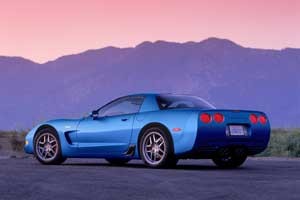 z06-prev1
z06-prev1
Suspension Refinements for Enhanced Control
The 2002 Z06 Corvette didn’t just receive a power boost; it also benefited from carefully engineered suspension upgrades. The Z06-specific FE4 High-Performance suspension system, already renowned for its capabilities, was further refined for the new model year. It features a larger diameter front stabilizer bar, a stiffer rear leaf spring, and meticulously calibrated camber settings. These elements work in harmony to deliver maximum control and precision, especially during demanding high-speed maneuvers. The 2002 Z06 also incorporates new rear shock valving, specifically tuned to provide a more controlled and refined ride, both on the track and on public roads.
While retaining the distinctive design and finish, the unique aluminum Z06 wheels underwent a subtle manufacturing change. For the 2002 model year, these wheels are produced using a cast process rather than the previous forged method. It’s also worth noting that the magnesium wheel option, previously available for Coupe and Convertible models, was discontinued for 2002.
Agility and Handling Prowess
The Corvette’s renowned agile handling characteristics are fundamentally rooted in its hydroformed frame rails, providing an exceptionally rigid and lightweight foundation. The four-wheel independent front suspension system features cast aluminum upper and lower A-arms, contributing to reduced unsprung weight and enhanced responsiveness. For the 2002 model year, both the Z06 and models equipped with the optional Z51 performance package received further weight optimization with the introduction of aluminum front stabilizer bar links. The independent rear suspension continues to utilize a transverse leaf spring system, a hallmark of Corvette engineering.
All 2002 Corvettes came standard with the second-generation Active Handling system. This sophisticated electronic stability control system incorporates dynamic rear brake proportioning to effectively prevent rear wheel lockup under hard braking. Rear brake stability control assists drivers in maintaining control during light braking and high acceleration scenarios. The integral traction control system is calibrated to allow drivers to experience the Corvette’s potent power and exceptional handling while mitigating excessive wheelspin. For track enthusiasts and experienced drivers, the system includes an on/off switch and a “Competitive Mode.” Competitive Mode allows drivers to disengage the traction control element while still benefiting from the other stability enhancements offered by Active Handling.
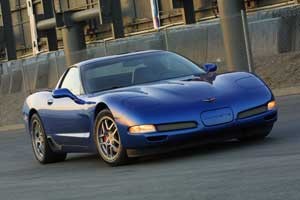 z06-slant-prev
z06-slant-prev
Additional Enhancements for 2002
Previously an option, the Head-Up Display (HUD) became standard equipment on the 2002 Z06. This feature projects crucial vehicle information, including speed and various gauge readings, directly onto the windshield in the driver’s line of sight. This innovative system allows drivers to monitor critical data without taking their eyes off the road, enhancing both performance driving and overall safety. HUD remained an available option for Coupe and Convertible models.
For 2002, engineers transitioned the automatic transmission cooler case from stainless steel to a lighter cast aluminum construction, further contributing to weight reduction efforts.
In the realm of in-car entertainment, Coupes and Convertibles received an upgraded standard system featuring an AM/FM radio with an in-dash CD player. For those preferring cassette tapes, an AM/FM/Cassette system remained available when opting for the remote 12-disc CD changer. The 12-disc CD changer was also compatible with the standard CD radio.
The 2002 Corvette’s exterior color palette received a vibrant addition with Electron Blue, replacing the previously offered Navy Blue Metallic on Coupes and Convertibles. Electron Blue also superseded Speedway White as one of the five available exterior color choices for the Z06.
2002 Chevrolet Corvette Specifications Overview
| Category | Specification |
|---|---|
| Model: | Chevrolet Corvette: Coupe, Convertible, Z06 (hardtop) |
| Body Style/Driveline/Configuration: | Two-door hatchback coupe, convertible, and fixed-roof coupe, rear-drive, front-engine |
| Body Material: | Composite |
| EPA Vehicle Class: | Two-seater |
| Manufacturing Facility: | Bowling Green, Kentucky |
| Key Competitors: | Audi TT, BMW Z3, Dodge Viper, Porsche Boxster and Boxster S, Porsche 911 |
Engine Options: 5.7L V8 Power
| Engine Specification | 5.7L (LS1) V8 (Coupe, Convertible) | 5.7L (LS6) V8 (Z06) |
|---|---|---|
| Application: | Standard on Coupe, Convertible | Standard on Z06 |
| Type: | 5.7-liter OHV | 5.7-liter OHV |
| Displacement: | 350 cu in / 5665 cc | 350 cu in / 5665 cc |
| Block Material: | Cast aluminum | Cast aluminum |
| Cylinder Head Material: | Cast aluminum | Cast aluminum |
| Valvetrain: | Overhead valve, two valves per cylinder | Overhead valve, two valves per cylinder |
| Fuel Delivery: | SFI (Sequential Fuel Injection) | SFI (Sequential Fuel Injection) |
| Compression Ratio: | 10.1:1 | 10.5:1 |
| Horsepower: | 350 hp / 261 kW @ 5600 rpm | 405 hp / 302 kW @ 6000 rpm |
| Torque: | 375 lb-ft / 508 Nm @ 4400 rpm (manual) | 400 lb-ft / 542 Nm @ 4800 rpm |
| 360 lb-ft / 489 Nm @ 4000 rpm (automatic) | ||
| Recommended Fuel: | 93 octane | 93 octane |
| Maximum Engine Speed: | 6000 rpm | 6500 rpm |
| Emission Control System: | Catalytic converter, AIR | Catalytic converter, AIR |
| EPA Fuel Economy (mpg city/hwy/comb): | ||
| LS1 (manual) | 19/28/23 | N/A |
| LS1 (automatic) | 18/25/21 | N/A |
| LS6 (manual) | N/A | 19/28/23 |
Transmission Choices
| Specification | 4-speed Automatic (Coupe, Convertible) | 6-speed Manual (Coupe, Convertible) | 6-speed Manual (Z06) |
|---|---|---|---|
| Application: | Standard on Coupe and Convertible | Optional on Coupe and Convertible | Standard on Z06 |
| 1st Gear Ratio: | 3.06 | 2.66 | 2.97 |
| 2nd Gear Ratio: | 1.63 | 1.78 | 2.07 |
| 3rd Gear Ratio: | 1.00 | 1.30 | 1.43 |
| 4th Gear Ratio: | 0.70 | 1.00 | 1.00 |
| 5th Gear Ratio: | N/A | 0.74 | 0.84 |
| 6th Gear Ratio: | N/A | 0.50 | 0.56 |
| Reverse Ratio: | 2.29 | 2.90 | 3.28 |
| Final Drive Ratio: | 2.73 (Standard) / 3.15 (Optional) | 3.42 | 3.42 |
Chassis and Suspension
| Feature | Specification |
|---|---|
| Front Suspension: | Short/long arm (SLA) double wishbone, cast aluminum upper & lower control arms, transverse-mounted composite leaf spring, monotube shock absorber |
| Rear Suspension: | Short/long arm (SLA) double wishbone, cast aluminum upper & lower control arms, transverse-mounted composite leaf spring, monotube shock absorber |
| Stabilizer Bar Diameter: | Standard: 19.1 mm / 0.75 in, F45: 19.1 mm / 0.75 in, Z51: 21.7 mm / 0.85 in, FE4 (Z06): 21.7 mm / 0.85 in |
| Traction Control: | Electronic Traction Control, Active Handling |
| Steering Type: | Speed-sensitive power-assisted rack-and-pinion |
| Steering Ratio: | 16.1:1 |
| Turns Lock-to-Lock: | 2.66 |
| Turning Circle: | 40.2 ft / 12.1 m |
Braking System
| Feature | Specification |
|---|---|
| Type: | Power-assisted disc with ABS, front and rear |
| Front Brakes: | 12.6 x 1.26-inch (325 x 32-mm) discs |
| Rear Brakes: | 11.8 x 1.0-inch (305 x 26-mm) discs |
| Swept Area (Front): | 263 sq. in., 1696 sq. cm |
| Swept Area (Rear): | 158 sq. in., 1018 sq. cm |
Wheels and Tires
| Specification | Coupe and Convertible | Z06 |
|---|---|---|
| Wheels (Front): | 17 X 8.5 Cast Aluminum (Standard), Forged Aluminum, High Polish (Optional) | 17 X 9.5 Cast Spun Aluminum |
| Wheels (Rear): | 18 X 9.5 Cast Aluminum (Standard), Forged Aluminum, High Polish (Optional) | 18 X 10.5 Cast Spun Aluminum |
| Tires (Standard): | Goodyear Eagle F1 GS, extended mobility | Goodyear Eagle F1 SC, Asymmetric Tread |
| Tire Size (Front): | P245/45ZR-17 | P265/40ZR-17 |
| Tire Size (Rear): | P275/40ZR-18 | P295/35ZR-18 |
Exterior Dimensions
| Dimension | Coupe | Convertible | Z06 |
|---|---|---|---|
| Wheelbase: | 104.5 in / 2655.5 mm | 104.5 in / 2655.5 mm | 104.5 in / 2655.5 mm |
| Overall Length: | 179.7 in / 4565.6 mm | 179.7 in / 4565.5 mm | 179.7 in / 4565.5 mm |
| Width: | 73.6 in / 1869.4 mm | 73.6 in / 1869.4 mm | 73.6 in / 1869.4 mm |
| Height: | 47.7 in / 1211.5 mm | 47.8 in / 1214.7 mm | 47.7 in / 1211.5 mm |
| Front Track: | 61.9 in / 1572.3 mm | 61.9 in / 1572.3 mm | 62.4 in / 1584.5 mm |
| Rear Track: | 62.0 in / 1574.5 mm | 62.0 in / 1574.5 mm | 62.6 in / 1589.5 mm |
| Curb Weight: | 3246 lbs / 1472 kg | 3248 lbs / 1473 kg | 3118 lbs / 1414 kg |
| Weight Distribution (F/R): | 51/49 | 51/49 | 53/47 |
Interior Dimensions
| Dimension | Coupe | Convertible | Z06 |
|---|---|---|---|
| Seating Capacity: | 2 | 2 | 2 |
| Head Room (Front): | 37.9 in / 963 mm | 37.9 in / 963 mm | 37.8 in / 960 mm |
| Leg Room (Front): | 42.7 in / 1085 mm | 42.7 in / 1085 mm | 42.7 in / 1085 mm |
| Shoulder Room (Front): | 55.3 in / 1405 mm | 55.3 in / 1405 mm | 55.3 in / 1405 mm |
| Hip Room (Front): | 54.2 in / 1377 mm | 54.2 in / 1377 mm | 54.2 in / 1377 mm |
Capacities
| Capacity | Coupe | Convertible | Z06 |
|---|---|---|---|
| Cargo Volume: | 24.8 cu ft / 702 liters | 13.9 cu ft / 394 liters | 13.3 cu ft / 377 liters |
| Fuel Tank Capacity: | 18.5 gal / 70.0 liters | 18.5 gal / 70.0 liters | 18.5 gal / 70.0 liters |
| Engine Oil (with filter): | 6.5 qts / 6.15 liters | 6.5 qts / 6.15 liters | 6.5 qts / 6.15 liters |
| Engine Coolant: | 11.5 qts / 10.9 liters (automatic) | 11.5 qts / 10.9 liters (automatic) | 11.5 qts / 10.9 liters (automatic) |
| 11.8 qts / 11.2 liters (manual) | 11.8 qts / 11.2 liters (manual) | 11.8 qts / 11.2 liters (manual) |
2002 Z06 Corvette: Perfection Redefined
The 2001 Chevrolet Z06 Corvette was met with overwhelming critical acclaim and quickly captured the hearts of Corvette enthusiasts worldwide. Many considered the 2001 Z06 to be the epitome of sports car perfection, praised for its exceptional performance, agility, and control, all wrapped in a visually stunning design. However, for 2002, Chevrolet engineers sought to redefine “perfection,” pushing the Z06 even further.
For nearly five decades, Corvette has been synonymous with high-performance. Embracing the philosophy that “you can never have too much of a good thing,” GM engineers meticulously extracted an additional 20 horsepower from the already potent LS6 engine that debuted in the 2001 Z06. The result: the 2002 LS6 engine now delivered an awe-inspiring 405 horsepower at 6,000 rpm.
“We could have rested on our laurels with the achievements of the 2001 model, but instead, we set our sights on breaching the 400-horsepower barrier,” explained Dave Hill, Performance Cars Vehicle Line Executive and Corvette Chief Engineer. “At 405 horsepower, the LS6 matches the peak power output of the legendary 5.7-liter DOHC LT5 engine that powered the iconic ZR1 Corvette.”
Torque: The Key to Enhanced Performance
“When customers express their desire for more power, what they truly crave is more torque,” Hill clarified. “Torque is the driving force that propels you forward, whether launching from a standstill or accelerating out of a corner. The 2001 Z06, with 385 lb-ft of torque, was already in an elite performance class. For 2002, we raised the bar even higher, adding another 15 lb-ft of torque, culminating in a total of 400 lb-ft at 4,800 rpm. The resulting performance is something that must be experienced firsthand to be truly appreciated.”
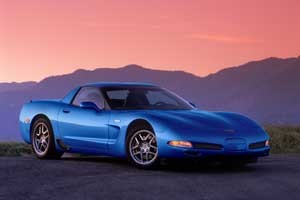 z06-prev2
z06-prev2
The 2002 Z06 continued to be equipped exclusively with the robust six-speed manual transmission, perfectly complementing its high-performance character. This powertrain combination empowers skilled drivers to achieve blistering 0-60 mph acceleration in just 3.9 seconds and conquer the quarter-mile sprint in a mere 12.4 seconds at 116 mph. To put this in perspective, the 2001 Z06 achieved 0-60 mph in 4.0 seconds and the quarter-mile in 12.6 seconds at 114 mph. These seemingly small improvements translate to a noticeable leap in real-world performance.
LS6 Clutch System Enhancements
To effectively manage the increased torque output of the upgraded LS6 engine, the clutch system underwent a significant redesign. Clamp load was increased by seven percent, and overall durability was enhanced through several key improvements:
- The clutch-driven disc was redesigned with a 20 percent increase in flange plate thickness, from 5 mm to 6 mm.
- The damper springs were redesigned to feature an increased wind-up rate, from 33 Newton-meter degrees to 35 Newton-meter degrees.
- Premium alloy steel wire was implemented for the damper springs, enhancing strength and resilience.
These carefully engineered modifications ensured the LS6 clutch could reliably handle the increased power and torque while maintaining long-term durability and consistent performance.
World-Class Agility and Handling Refinements
“While the 2002 Z06 is undeniably the quickest Corvette to date, the Corvette engineering team remained steadfastly focused on the Z06 as a holistic performance package,” Hill emphasized. “With this guiding principle, the suspension system was further refined to ensure the Z06 retained its exceptional balance and solidified its position as the benchmark against which all other sports cars are measured.”
The valving of the Z06’s rear dampers was revised to optimize the transfer of the increased horsepower and torque to the road surface, resulting in smoother and more efficient power delivery. “Revising the damping characteristics allowed us to enhance both the track performance of the Z06 and its everyday ride quality,” explained Mike Neal, Corvette Ride and Handling Development Engineer. This delicate balance between track-focused performance and daily driving comfort is a hallmark of the Corvette Z06.
Beyond power and suspension upgrades, Corvette engineers meticulously examined every avenue for reducing vehicle mass, recognizing its direct impact on handling agility and responsiveness.
Their efforts yielded further weight savings through:
- Implementation of cast aluminum front stabilizer links, replacing rolled rod steel links, resulting in a 0.2 kg (0.44 lbs.) weight reduction.
- Adoption of cast-spun aluminum wheels, in place of forged aluminum wheels, achieving a total mass savings of 0.6 kg (1.3 pounds).
These weight-saving measures further enhanced the already world-class FE4 suspension system, which debuted in the 2001 Z06, contributing to even sharper handling and improved agility.
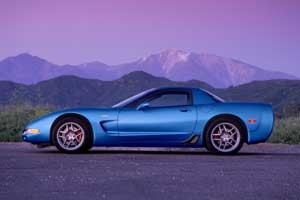 z06-prev3
z06-prev3
A Solid Performance Foundation
“The 2002 Z06 Corvette represents the complete performance package, a vehicle engineered to inspire supreme confidence when driven at the limit,” Hill stated. “It is a true driver’s car, meticulously designed to provide the driver with the essential information and feedback required for truly enthusiastic driving experiences.”
The 2002 Z06 builds upon the robust foundation established by its predecessor, a model that had already elevated performance to unprecedented levels. The 2001 Z06 introduced the standard Second-Generation Active Handling system, providing a significant layer of driver assistance and enhanced safety for occupants.
The 2001 Corvette coupe, convertible, and Z06 models collectively set new benchmarks in refinement, characterized by improved noise isolation, enhanced idle quality, reduced maintenance demands, and improved fuel economy. The 2002 Z06 continues this trajectory of refinement while amplifying its performance capabilities.
Further emphasizing its performance focus, the 2002 Z06 model now included a standard Head-Up Display (HUD). HUD projects critical vehicle information – including tachometer readings, vehicle speed, oil pressure, coolant temperature, and fuel gauges – directly onto the windshield, promoting a “hands on the wheel, eyes on the road” driving philosophy.
“We acknowledge that the Z06 is not intended for every driver,” stated Tadge Juechter, Performance Cars Assistant Chief Engineer. “However, for the most ardent performance enthusiasts, the race-bred 2002 Z06 provides a vehicle that fearlessly challenges the boundaries of performance and handling, with absolutely no compromises. The 2002 Z06 is unequivocally a total performance package!”
LS6 Engine Specifications: Model Year 2002
| Specification | Detail |
|---|---|
| Type: | 5.7L V8 |
| Displacement: | 5665cc |
| Compression Ratio: | 10.5:1 |
| Valve Configuration: | Overhead Valves (OHV) |
| Assembly Site: | St. Catharines, ON |
| Valve Lifters: | Hydraulic Roller |
| Firing Order: | 1 – 8 – 7 – 2 – 6 – 5 – 4 – 3 |
| Bore x Stroke: | 99.00 x 92.00mm |
| Fuel System: | Sequential Fuel Injection (SFI) |
| Horsepower: | 405 hp @ 6000 rpm |
| Torque: | 400 lb-ft @ 4800 rpm |
| Fuel Shut Off: | 6600 rpm |
| Emissions Controls: | Catalytic Converter, Three-Way Catalyst, AIR, PCV |
| Applications: | Chevrolet ZO6 Corvette (option) |
Materials:
| Component | Material |
|---|---|
| Block: | Cast Aluminum |
| Cylinder Head: | Cast Aluminum |
| Intake Manifold: | Composite |
| Exhaust Manifold: | Cast Nodular Iron |
| Main Bearing Caps: | Powder Metal |
| Crankshaft: | Cast Nodular Iron |
| Camshaft: | Hollow Steel |
| Connecting Rods: | Powder Metal |
Key LS6 Engine Enhancements for 2002:
- Improved Air Filter: A redesigned air cleaner housing with a larger opening increases airflow into the engine.
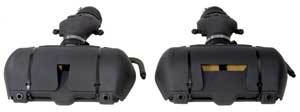 ls6-newairfilter-right
ls6-newairfilter-right
-
Improved MAF Sensor: A new Mass Air Flow (MAF) sensor design eliminates pre-sensor grid work, reducing intake restriction.
-
Hollow Stem Valves: New hollow stem valves, particularly for the exhaust side, reduce valvetrain mass and improve heat dissipation.
-
Higher Lift Camshaft: A revised camshaft profile with increased valve lift enables greater airflow into and out of the cylinders, contributing significantly to the power increase.
Additional LS6 Features: Extended Life Spark Plugs, Extended Life Coolant, Oil Level Sensor, Engine Oil Life Monitoring.
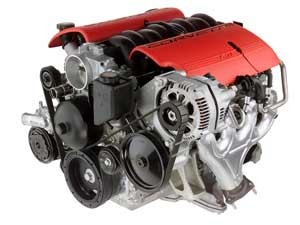 ls6-frontside
ls6-frontside
LS6: Side View
LS6 Engine Performance Comparison Charts (PDF Downloads):
- LS6 Camshaft Comparison 2001 vs 2002
- 2002 LS6 w/Manual vs 2002 LS1 w/Automatic
- 2002 LS6 w/Manual vs 2002 LS1 w/Manual
- 2001 LS6 vs 2002 LS6 5.7L V8
Corvette Durability Testing: Maintaining “America’s Favorite Sports Car” Status
Chevrolet Corvette has long been recognized as “America’s favorite sports car,” a title earned through its consistent delivery of proven power and exceptional performance in a production vehicle. Chevrolet takes immense pride in this legacy and remains dedicated to ensuring the Corvette remains an automotive icon for generations to come. To uphold these standards, every Corvette undergoes rigorous durability testing, mirroring the stringent protocols applied to all General Motors vehicles. However, Corvette testing goes above and beyond, incorporating three additional demanding tests – 250 miles of autocross, 24 hours of continuous racetrack driving, and top speed runs at wide-open throttle – meticulously designed to validate the Corvette’s readiness for high-performance applications.
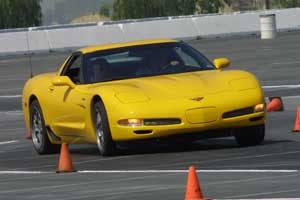 It
It
“It’s crucial to remember that with Corvette, and especially with the Z06, buyers are acquiring a vehicle that has been comprehensively tested under every conceivable condition,” emphasized Dave Hill.
Autocross Endurance Test
The autocross phase of testing involves subjecting the Corvette to 250 miles of intense driving on a demanding autocross course. Completing this distance typically requires approximately five full tanks of fuel, with thorough vehicle inspections performed at each refueling stop. Throughout the autocross test, sophisticated instrumentation continuously monitors a wide array of parameters, from oil pressure to transmission temperature, providing real-time data on the vehicle’s performance under stress. This rigorous autocross test serves as a critical precursor to the even more demanding 24-hour racetrack endurance test.
24-Hour Racetrack испытание
Following the autocross evaluation, the Corvette faces the ultimate endurance challenge: 24 hours of continuous driving at competitive speeds on a dedicated road course.
“It’s effectively equivalent to 24 individual sprint races, each lasting a full hour,” explained Mike Neal, Corvette ride and handling chassis development engineer. “Approximately one hour at track speed is required to consume a full tank of fuel. After each hour, the car returns to the pit, where we conduct thorough checks, replenish fluids, replace brake components and tires as needed, download data from our instrumentation, and then send the car back onto the track. This cycle is repeated until the car has completed a full 24 hours of continuous track driving.”
The 2.2-mile road course used to validate the 2002 Z06 incorporates a diverse range of challenges, including a 120-mph straightaway, 90-mph sweeping curves, and tight 40-mph hairpin turns. During each lap, drivers execute approximately 12 gear shifts and apply the brakes 10 times, subjecting the vehicle to constant and intense stresses. “Compared to the 2001 Z06, the 2002 model is approximately half a second faster around our demanding test track,” Neal added, highlighting the incremental yet significant performance improvements.
Throughout the 24-hour test, a comprehensive array of sensors and data acquisition equipment monitors and records 30 channels of thermal information from critical components and fluids. In addition to temperature readings, other vital data is meticulously collected and analyzed, including oil pressure, engine rpm, vehicle speed, lateral acceleration, and longitudinal acceleration forces.
“For the Corvette, this additional testing regimen is absolutely essential in validating the robustness and durability of the vehicle for demanding racing applications,” Neal emphasized. “In the case of the 2002 Z06, the track-testing phase played a crucial role in our engineering decision to develop a new, more robust clutch design to handle the increased power output.”
The clutch system in the 2001 Z06 had already been enhanced to accommodate the increased power of the LS6 engine compared to the base LS1. However, with the additional power boost for the 2002 LS6, a completely redesigned clutch was deemed necessary to ensure long-term reliability and consistent high-performance operation under extreme conditions.
“Our 24-hour racing speed endurance test serves as an invaluable complement to our standard durability testing protocols,” Dave Hill affirmed. “It’s a uniquely severe test that provides Corvette with the exceptional robustness and resilience that our discerning owners expect. This rigorous testing is a key differentiator that sets the Corvette apart from its competitors.”
Top Speed Wide-Open Throttle Test
To simulate sustained high-speed autobahn driving conditions, the Corvette undergoes a wide-open throttle test on a five-mile circle track at the Milford Proving Grounds in Milford, Michigan. Starting with a full tank of fuel, the car is driven at its maximum 171-mph top speed until the fuel tank is depleted, a process that typically lasts around 30 minutes. This extreme test validates the vehicle’s ability to reliably withstand sustained extreme thermal loads generated at top speed.
Performance Validation Through Rigorous Testing
“It is paramount to remember that when purchasing a Corvette, especially a Z06, buyers are investing in a vehicle that has been thoroughly validated under all conceivable conditions,” Dave Hill reiterated. “Our rigorous and comprehensive testing protocols ensure that the Corvette can confidently tackle demanding race track environments while still providing reliable and comfortable transportation in everyday driving situations. This unwavering commitment to rigorous testing further solidifies the Corvette’s legendary status as America’s favorite sports car.”
Corvette Enthusiasts Celebrate Historic Power Increase
The 2002 5.7-liter Overhead Valve (OHV) LS6 engine powering the ZO6 Corvette achieved a remarkable 405 horsepower rating. This 20-horsepower increase translates to an impressive 71 horsepower per liter from the 5665 cc engine, representing the highest specific output ever attained in a Gen III small-block engine.
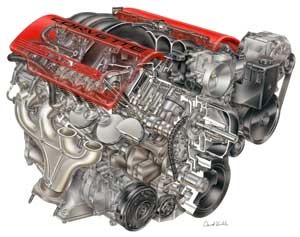 The new LS6 V8 delivers 405 horsepower at 6000 rpm and 400 lb-ft of torque at 4800 rpm.
The new LS6 V8 delivers 405 horsepower at 6000 rpm and 400 lb-ft of torque at 4800 rpm.
The enhanced LS6 V8 achieves its 405 horsepower peak at 6000 rpm and generates 400 lb-ft of torque at 4800 rpm. This power increase was realized through a series of carefully engineered engine modifications, including a revised air cleaner housing, a low restriction Mass Air Flow (MAF) sensor, lightweight valves, a higher lift camshaft, and exhaust system alterations.
The component modifications responsible for the additional 20 horsepower and 15 lb-ft of torque (compared to the 2001 LS6) are all focused on optimizing airflow into and out of the engine. Increasing the volume of air flowing through the engine is fundamental to generating more power. Air initially enters through the redesigned air cleaner housing. The new air box opening to the air cleaner boasts an increase of approximately 6.65 square inches (43 cm2), contributing to enhanced horsepower output.
The new MAF sensor design eliminates pre-sensor grid work, previously known as air channels. This streamlined design allows induction air to flow with less restriction through the mass air flow sensor and into the intake manifold, minimizing airflow impediments.
Gases flowing into and out of the combustion chamber pass through new hollow stem valves. The stems of the exhaust valves are filled with a liquid sodium alloy. Given that exhaust valves operate at significantly higher temperatures than intake valves, this liquid alloy facilitates more efficient heat transfer from the exhaust valves to the valve guides and subsequently to the engine coolant. These lightweight valves contribute to a valvetrain mass reduction of approximately 368 grams, allowing the valves to maintain optimal contact with the camshaft at higher engine speeds.
The revised camshaft profile is the most significant contributor to the power increase. The new profile increases both intake and exhaust valve lift by 0.7 mm. This seemingly small but critical change enables a greater volume of air to be pumped into and out of the cylinders, directly translating to increased power output. Each camshaft undergoes induction hardening and straightening to a precise accuracy of ten microns to ensure true and consistent rotation within the engine. All 16 lobes are meticulously inspected using advanced opto-electrical technology with submicron level precision.
For the 2002 Z06, the exhaust system was further optimized by eliminating the dual pup catalytic converters previously located immediately downstream from the exhaust manifolds. Removing these converters reduces exhaust backpressure and increases exhaust flow out of the engine. The underfloor catalytic converters were modified to compensate for the removal of the pup converters and ensure continued compliance with stringent NLEV emissions standards.
With 405 horsepower, the 2002 LS6 engine matches the peak power output of the legendary 5.7-liter DOHC LT5 engine that powered the iconic ZR1 Corvette from 1990 to 1995. For enthusiasts of OHV V8 engines and the broader engineering community, this achievement represents a significant milestone in engine development.
The LS6 engine was made possible by leveraging the advanced Gen III architecture introduced with the 1997 LS1 engine. This innovative small-block design incorporated features such as a deep skirt aluminum block, cross-bolted main bearing caps, an internally balanced crankshaft, electronic throttle control, and coil-near-plug ignition. The Gen III small block retained the inherent simplicity of the OHV design while integrating cutting-edge engine technologies.
Assistant Chief Engineer John Juriga commented on the new power level: “With the advent of the 2002 OHV LS6, GM Powertrain continues to demonstrate its unwavering ability to deliver exceptional power and performance in a compact engine package, consistently exceeding customer expectations.”
An Interview with Sam Winegarden on the 2002 LS6 Engine
Sam Winegarden, Chief Engineer for GM Powertrain’s Small Block team, recently shared his insights on the launch of the groundbreaking 2002 LS6 engine. The LS6, the 5.7L V8 powerhouse for the Z06 Corvette, marked a significant milestone by exceeding the 400 horsepower threshold. Sam has served as Chief Engineer for the Small Block program for over three years, providing him with a unique perspective on this iconic engine family.
1) Can you describe what it’s like to work on the Small Block program?
“When you consider automotive icons and brands, nothing is more enduring and widely recognized than the Small Block Chevy. Working on this program means you’re working on a legend. You’re also deeply connected to the heart and soul of the Corvette and nearly every truck we produce. The Small Block engine is central to a significant portion of GM’s North American production volume and profitability. It’s both exhilarating and humbling. You’re essentially entrusted with the care of a legend.”
 Sam Winegarden, chief engineer for GM Powertrain
Sam Winegarden, chief engineer for GM Powertrain
“The introduction of the new LS6 has been incredibly energizing for our team. Generating horsepower is always exciting and ignites tremendous enthusiasm. The ability to match the legendary LT5 engine’s power output was a major source of pride and motivation for the team. It represents another step forward, another level of performance in the storied history of the Small Block, and the team was incredibly enthusiastic about pursuing that goal. It was a truly rewarding experience.”
2) With 405 HP in the LS6, you’ve surpassed many of the muscle car era’s gross power levels. That’s a significant achievement.
“John Juriga (Assistant Chief Engineer) and his team have executed what I would describe as a relentless pursuit of horsepower. The Small Block team has done an exceptional job of extracting every last bit of horsepower possible from this engine. It’s an incredibly thrilling accomplishment to be a part of.”
3) You’ve achieved comparable power to the legendary LT5 with an OHV design. Any comments on this historic achievement and its impact on the industry?
“It’s simply another chapter in the long and remarkably successful history of the Small Block engine. The team continues to perform at an outstanding pace of innovation and development. From an industry perspective, it demonstrates that there is more than one engineering approach to achieving high horsepower. Conventional wisdom might suggest that a four-valve overhead cam arrangement is essential for this level of power, but that’s simply not the case. You can achieve remarkable results with either approach, and John and the team have definitively proven that. From an industry standpoint, it underscores that the pushrod Small Block has a vibrant future, and there’s even more performance potential to be unlocked.”
4) Do you think this power boost will resonate well with Corvette fans?
“Absolutely. While 20 horsepower might not sound like a massive number on paper, when you actually drive the vehicle, as Dave Hill (Corvette Chief Engineer) aptly put it, ‘it makes the car really come alive.’ The increased responsiveness and acceleration are readily apparent and will undoubtedly be appreciated by Corvette enthusiasts.”
5) Did you meet the Corvette team’s requirements for power and torque levels?
“Yes, in fact, we slightly exceeded them. The initial target was 400 horsepower, and we achieved 405 horsepower.”
6) Having been the Chief Engineer for GM’s Premium V engine family, what engineering processes are being carried over into the Small Block program?
“There’s significant synergy in several key areas, particularly in our ‘Bill of Design’ process. The Bill of Design is essentially a comprehensive set of best engineering practices refined over years of experience to ensure the highest quality and most effective engine designs. While the Premium V engine family and the Small Block are distinct architectures – one being a four-valve overhead cam design and the other a two-valve pushrod – many fundamental engineering principles related to cylinder head design, block structure, and piston design are universally applicable. For example, the robust lower-end structure of both the Corvette engine and the Premium V engines reflects similar engineering philosophies, albeit implemented with different solutions – a deep skirt with a six-bolt arrangement in one case and a bed plate in the other. Both exemplify outstanding bottom-end structural integrity. The Small Block, in particular, boasts what is likely the most robust lower end I’ve ever encountered – virtually bulletproof. The team did an exceptional job in this area.”
7) What guiding philosophy should drive engine development for the Corvette?
“The primary guiding principle is that the Corvette must offer the best performance value on the road, period. Therefore, a relentless focus on power and performance is paramount. However, it’s equally crucial to seamlessly integrate the engine into the overall vehicle. Simply producing raw power in isolation is insufficient; it must be effectively harnessed and integrated to create a truly rewarding and exciting driving experience. Working collaboratively with the Corvette team has been incredibly rewarding because, together, we’ve not only achieved legendary performance numbers but also packaged that performance within a vehicle that remains remarkably refined for its performance capabilities. The overarching principle is to execute everything with unwavering quality. Producing immense horsepower at the expense of engine reliability is simply not a viable strategy.”
8) For 2002, the LS6 gained 20 HP. Why wasn’t this power available in the initial LS6 release the previous year?
“To be candid, we weren’t quite ready for the 2001 launch. We encountered some valvetrain challenges that required further refinement. Reducing valve mass and effectively managing the aggressive ramp rates on the camshaft proved to be complex engineering hurdles. While there were other challenges, the valvetrain was the most intricate aspect to fully resolve and balance. We are committed to delivering only fully validated and quality-assured solutions. Not having completely resolved these valvetrain issues in the final weeks leading up to 2001 production, we made the strategic decision to implement the power enhancements in a two-step approach, with incremental improvements in 2001 and 2002. It was purely a matter of ensuring we were fully prepared. We adhere to the principle of delivering only when the product is truly ready.”
9) Did you ever consider expanding the bore or stroke of the LS6?
“Some of the valuable learnings derived from the power development efforts on this program are definitely slated to inform future model year enhancements.”
 sam_winegarden2
sam_winegarden2
10) The 6600 rpm redline for the LS6 is impressive for a pushrod V8. Why is the LS1 in the base Corvette fuel cutoff set lower at 6200 rpm?
“We identified a threshold around 6200 rpm where valve float became a concern with the original valvetrain components. When you have a heavier valvetrain, one of the trade-offs is a reduction in higher rpm capabilities, necessitating a lower rev limit. The lower redline of the LS1 is a result of balancing factors like power output, fuel economy, and NVH (noise, vibration, and harshness) characteristics – a balance we carefully considered in collaboration with Dave Hill’s Corvette team.”
11) The LS6 engine beauty covers are red, visually distinguishing it from the LS1. Were there any discussions about visually differentiating the 2002 LS6 from the 2001 version?
“No, there were no changes to the engine covers to differentiate the 2002 LS6 from the 2001 version. However, the increased engine output is acknowledged on the exterior of the car. The 2002 Z06 features a badge incorporating ‘405’ integrated into the Z06 logo, visually signifying the horsepower increase.”
12) What is the projected production volume for the 2002 LS6 engine?
“We anticipate starting with approximately 20 percent of total Corvette production at Bowling Green being Z06 models, allowing us to gauge market demand for this specialized model. Regardless of the final volume, the St. Catharines Engine Facility is fully prepared to produce the required number of LS6 engines.”
13) Did removing the pup converters from the exhaust system increase emissions?
“No, emissions levels were not negatively impacted. We compensated for the removal of the pup converters by enhancing the underfloor catalytic converters. Advancements in converter technology across GM Powertrain enabled us to implement these improvements effectively. The exhaust system modifications actually benefited power output by reducing backpressure, which is always a desirable outcome for performance.”
14) Will this version of the LS6 still operate effectively on regular fuel, or is premium fuel still recommended?
“Premium fuel is still recommended to achieve optimal performance. However, the LS6 will operate effectively on regular fuel. The ESC (Electronic Spark Control) system is designed to adapt to different fuel grades. There will be a slight reduction in performance when using regular fuel, primarily noticeable under heavy loads at low speeds and at the extreme top end of the rpm range. The system retards spark timing to prevent knock, which slightly reduces torque output. For everyday driving around town, the difference will likely be imperceptible. However, for track driving or maximum performance scenarios, premium fuel is recommended to unlock the engine’s full potential.”
15) What’s your favorite year Corvette?
“The 2002 Z06. If you can’t step out of that car with a grin on your face, you’re in the wrong profession.”
16) And your second favorite?
“The 1963 Sting Ray. From a historical perspective, that’s the one I admire most.”
2002 Corvette Model and Option Pricing (MSRP)
| Code | Description | MSRP |
|---|---|---|
| 1YY07 | Corvette Coupe | $40,805.00 |
| 1YY37 | Corvette Z06 | $49,505.00 |
| 1YY67 | Corvette Convertible | $47,330.00 |
| 1SA | Preferred Equipment Pkg (Coupe/Z06/Convertible) | $0.00 |
| 1SB | Preferred Equipment Pkg (Coupe/Convertible) | $1,700.00 / $1,800.00 |
| 1SC | Preferred Equipment Pkg (Coupe/Convertible) | $2,700.00 / $2,600.00 |
| R8C | Museum Delivery | $490.00 |
| G92 | Performance Axle Ratio | $300.00 |
| F45 | Selective Handling Pkg | $1,695.00 |
| V49 | License Plate Frame | $15.00 |
| DD0 | Electrochromic Mirrors (Z06/Reqs AAB) | $120.00 |
| B84 | Body Side Moldings | $75.00 |
| AAB | Memory Pkg (Z06/Reqs DD0) | $150.00 |
| Z51 | Performance Handling Pkg | $350.00 |
| 79U | Millennium Yellow Paint | $600.00 |
| 86U | Magnetic Red Metallic Paint | $600.00 |
| U1S | 12 Disc CD Changer | $600.00 |
| UL0 | AM/FM Cassette (Coupe/Convertible Reqs U1S) | ($100.00) |
| C2L | Dual Roof Panels (Coupe) | $1,200.00 |
| CC3 | Transparent Roof Panel (Coupe) | $750.00 |
| MN6 | 6 Speed Manual Trans (Coupe/Convertible) | $815.00 |
| MX0 | Automatic Trans (Coupe/Convertible) | $0.00 |
| QF5 | Polished Aluminum Wheels | $1,200.00 |
| 704 | Z06 Modified Interior Torch Red/Black | $0.00 |
| Destination Charges | $645.00 |
